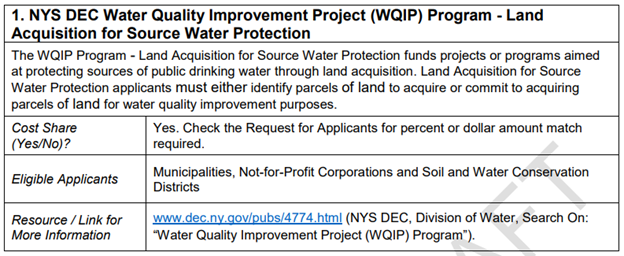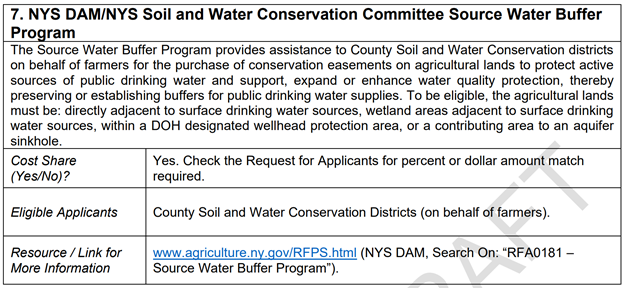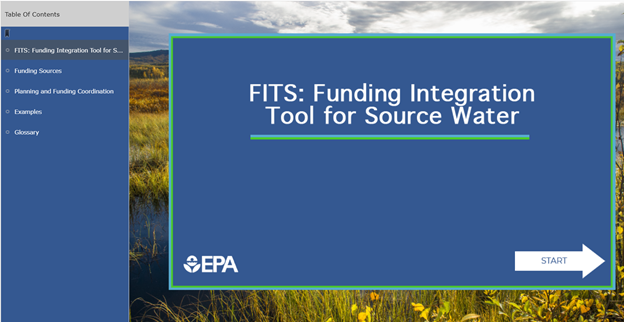Drinking Water Source Protection Program –January NewsletterThis issue’s topics:
|
Technical Assistance Providers Available to Protect Your Drinking Water!Have you heard the good news? The State is offering a free technical assistance provider (TA provider) to communities interested in developing and implementing a Drinking Water Source Protection Program (DWSP2) Plan for their source(s) of drinking water. If you and your community are interested in working with a TA provider, apply today or visit the DWSP2 webpage for more details. The application should take only 20-30 minutes to fill out. Once completed, submit the application by using the submit button at the bottom of the PDF. Any questions can be directed to the DWSP2 Team at source.water@dec.ny.gov. What can I expect?TA providers work with each community every step of the way, using the DWSP2 Framework, to develop a DWSP2 Plan specific to their community and drinking water source. TA providers will:
Fill out an application today! Various Funding Sources for DWSP2 Plan ImplementationDeveloping a DWSP2 plan lays the foundation for protecting your source water, but implementing the protection and management methods, developed by your stakeholder group, is what will help to ensure your source water is protected for years to come. That sounds great but protection and management methods can be costly for communities, Is there funding assistance available? Yes! there are multiple funding sources that can be used to implement many of the strategies included or recommended in a Drinking Water Source Protection plan. Let’s jump right into those resources. DWSP2 Framework Funding SourcesA great first stop to learn what funding assistance may be available is the DWSP2 Framework. The Framework was not only created to aid communities with developing a source water protection plan, but also providing resources and information, such as funding, to implement many of the protection and management methods the plan may include. Currently, the Framework identifies 24 state and federal funding sources that municipalities can apply for. Funding strategies included in the framework could aid with methods such as:
Each funding source has its own table which includes a summary of the program, if there is a cost share component, who the eligible applicants are, and where the potential applicant can go for more information. Let’s take a closer look at some of the funding programs that we include in our Framework. WQIP Land Acquisition Projects for Source Water ProtectionThe Water Quality Improvement Project (WQIP) grant program provides funding to municipalities, land trusts, and soil and water conservation districts to acquire land or conservation easements near a public drinking water source. This land acquisition funding source typically has a low local match requirement (e.g. 25%) and high maximum award amount (e.g. $4,000,000). There have been four rounds of land acquisition projects awarded to date. This includes 47 grant awards totaling more than $60 million. What can these projects look like? The NYS Conservationist Magazine included an article highlighting land trusts and their completed WQIP Land Acquisition projects which are protecting New York’s public drinking water sources. Jump to page 24 of the August/September 2021 issue to read more!
The Water Quality Improvement Project (WQIP) Program – Land Acquisition for Source Water Protection funding strategy table from the DWSP2 Framework. The Source Water Buffer ProgramLike the WQIP Land Acquisition program, the goal of the Source Water Buffer Program is to protect public drinking water and to enhance water quality protection. The Program funds the purchase of conservation easements and the implementation of buffer systems, which filter surface runoff or shallow groundwater to protect the water quality of New York State’s aquifers, watersheds, reservoirs, lakes, rivers, and streams. Approximately $5 million is available for conservation projects with a required match of 25% of total eligible costs. Soil and Water Conservation Districts are eligible to apply. This funding source is currently accepting applications on a rolling basis. For more information and where to apply, visit Ag & Markets Source Water Buffer Program webpage.
The Ag & Markets/Soil and Water Conservation Committee Source Water Buffer Program funding strategy table from the DWSP2 Framework. We will continue to highlight funding sources, even some new ones, as we become aware of them or the application is made available. Funding Integration Tool for Source Water (FITS)Another resource that recently became available and could aid with implementation and protection methods is the Funding Integration Tool for Source Water (FITS). EPA’s Source Water Protection Program recently released this new and innovative tool that helps users navigate and leverage funding opportunities for activities that protect sources of drinking water. FITS includes information on several federal funding sources and outlines how these funding sources may be used for activities related to source water protection planning and implementation. The web-based tool provides tips for long-term cross-program planning and includes multiple examples on how these funding sources have been leveraged in the past. The funding programs described within the tool, while not developed for source water protection, may support activities that protect sources of public drinking water.
The main page of the Funding Integration Tool for Source Water (FITS) Who should use FITS?This one stop shop tool can be used by municipalities, states, tribes, and territories; federal agencies; watershed stakeholders; drinking water utilities; and users who are engaged with activities that protect sources of drinking water. While every funding source may not be available for a municipality to apply for, there are a few that could aid with protection and management methods indirectly. For example, the NRCS Conservation Program Funds is a volunteer program for eligible agricultural producers to help manage natural resources on eligible land. While the municipality may not work with the funding program directly, utilizing their drinking water source protection map, they could make connections with the producer and this funding source. If the producer chooses to participate, the municipality can protect their drinking water source simply by making a connection! If you would like to learn more about FITS, visit EPA’s FITS: Funding Integration Tool for Source Water webpage. The webpage also includes links to other funding sources you may find useful to protect your source water. Share Your ThoughtsHave you begun the DWSP2 process? Or do you have a program or are you aware of a program relevant to source water? Send in any helpful hints or information at source.water@dec.ny.gov and we may highlight them! Sign UpTo sign-up for the DWSP2 newsletter, visit the DWSP2 webpage or click here. Newsletter ArchiveMissed last month’s edition? Visit the DWSP2 Newsletter Archive to stay up to date. |





